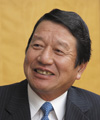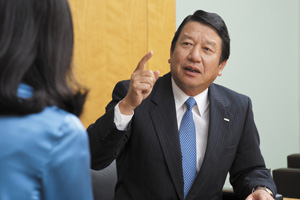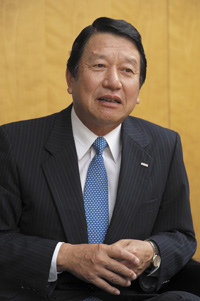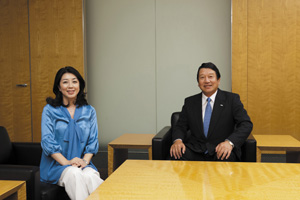 |
|
|
|
|
|
View from the Top Vol. 9, No. 12, pp. 1–5, Dec. 2011. https://doi.org/10.53829/ntr201112tp1  Cultivating Wisdom and Ability by Working Together Toward a Common Objective— ONE docomo: Focusing on Customers, Handsets, the Network, After-sales Service, and Safety & SecurityOverviewFollowing the Great East Japan Earthquake of March 2011, NTT DOCOMO worked fervently to restore facilities. With nearly all facilities restored in only about a month and a half, what was it about NTT DOCOMO that helped to achieve such a speedy response? We asked President and Chief Executive Officer Ryuji Yamada to tell us about the ONE docomo in-house campaign to raise customer satisfaction and the diverse services that have been born from this unified spirit at NTT DOCOMO. Achieving a quick response by getting and sharing all the facts—Mr. Yamada, please tell us about NTT DOCOMO’s response to the Great East Japan Earthquake of March 2011, an unprecedented disaster in the history of Japan. On hearing the first reports of this earthquake, I realized that it was an extraordinary emergency. The Primary Emergency Response System at NTT DOCOMO was immediately set in motion and I myself went over to the Disaster Countermeasures Headquarters on that day. Our first task was to check the status of our chain-of-command structure. To achieve a quick response at the time of a disaster, it is essential to obtain a clear understanding of current conditions and share such information. In our case, it was important to understand who would be working on what tasks, such as the restoration of transmission paths and restoration of base stations so that all concerned could proceed with their own duties. To this end, we held meetings three times a day after the earthquake to obtain a detailed view of current conditions. We also set up a system to facilitate quick decisions and action plans for critical matters by having top company leaders come together for meetings. It was also important for me as president to understand conditions in the field, and I made four visits to the stricken region to get first-hand views. The day after the earthquake, for example, I boarded a helicopter carrying relief supplies, and on the way to Kakuda City near Sendai, I saw with my own eyes the enormous damage caused by the tsunami on top of that caused by the earthquake. Upon seeing all of this, I issued instructions that 95% of our restoration efforts were to be devoted to the Pacific side of the stricken region. I think that this decision helped us mount a quick response. NTT DOCOMO had no previous experience with such a massive tsunami, and carrying out this restoration was proving to be a huge challenge. We came to realize that this restoration work would have to be a group effort that included affiliated companies. The earthquake disrupted 4900 base stations in the Tohoku region, but nearly all of them were restored by the end of April. In some cases, the damage was so great that base stations and antennas could not be restored at their original sites, so we worked to build up the coverage area by bringing in mobile base stations and installing large-zone base stations.
Working through the night to perform our dutiesWe received high praise from our customers for our restoration area map. This showed what locations were still without service and which were again providing services, as well as estimates of how many days it would take to restore services in specific areas. Providing this map was actually a bit risky since missing our restoration estimates might lead to complaints and just make things worse, but we felt that providing this information as a convenience for our customers was our first priority. We worked round-the-clock to develop this system and were able to complete it in only three days. Of course, the state of facilities and service-area restoration was changing day by day, so providing up-to-date information was essential. For this reason, our staff collected new information every evening at around 7 pm and worked through the night to process it so that it could be reflected in the restoration area map in the morning. Reflecting all lessons learned in future disaster countermeasuresThis earthquake reminded us just how crucial telecommunication services are to the safety and security of our customers. There is nothing more important to people during a disaster than being able to contact family members and others they are close to. We used the lessons learned from this devastating earthquake to develop and implement new disaster countermeasures, which we announced on April 28. For example, we decided to install large-zone base stations at NTT DOCOMO buildings having robust in-house power generation facilities. Base stations of this type will be activated whenever ordinary base stations are put out of commission by a natural disaster. A large-zone base station can cover a circular service area with a radius of approximately seven kilometers, which is far larger than that of ordinary base stations. In fact, installing large-zone base stations at 100 locations throughout Japan would cover about 35% of the population. Given the possibility of major earthquakes occurring in the Tokyo metropolitan area and the Tonankai region of Japan (south-central coast of Honshu island), we decided to prioritize the installation of large-zone base stations in those areas. We have already installed 37 large-zone base stations and plan to install more in order to reach a total of 100 units by the end of December 2011. We are also moving forward on the development of a voice-file message service. Immediately after the earthquake, the heavy concentration of voice calls on the network caused up to 90% of attempted calls to be restricted, which made it extremely difficult for people to make calls. By contrast, packet-based services like email were relatively easy to use at this time. This situation suggested the possibility of transmitting voice messages by means of packet communications while giving the user the same feel as a normal call when voice traffic becomes congested after a natural disaster. This service allows the user to use an ordinary telephone number to deliver a message and can therefore be used by people who are not familiar with email services. We expect to start providing this service by March 2012. At NTT DOCOMO, we plan to invest about 23 billion yen (about US$300 million) in the development and implementation of ten new disaster countermeasures, including the ones I just described. Except for a part of those countermeasures, such as the voice-file message service, we aim to complete them by the end of December. This earthquake taught us the importance of the division of roles between headquarters and the field. While respecting the judgments of field personnel directly involved in disaster response, then headquarters must make important decisions so that NTT DOCOMO can carry out its mission. Headquarters must also strive to look ahead and give instructions in anticipation of future developments. I know that the staff at headquarters works very hard, but we must not let pressures during extremely busy times overwhelm us. In this regard, we began to study the new disaster countermeasures that I just described early in April while facilities were still in the process of being restored, and we were able to make a statement about them at an earnings announcement press conference on April 28. I believe that this quick transition from countermeasure formulation to execution was a result of a united effort by NTT Group companies that understand that the customer is the number-one priority and that we must continue to provide a safe, secure, and trustworthy brand. Working together toward a common objective brings forth wisdom and ability. Our mission originates out of gratitude to our customersDisaster countermeasure formulation—and indeed, all of the work that we do at NTT DOCOMO—begins with a sincere feeling of gratitude to our customers. This feeling is essential to achieving true customer satisfaction. Let me explain this using smartphones as an example. Smartphone usage is growing rapidly, but because they are used differently from conventional mobile phones, we instituted changes in various areas so as not to inconvenience our customers. For example, each of our retail shops has at least one staff member who is a smartphone expert, so that customers with questions or problems can be given authoritative answers. We have also enlarged our smartphone-savvy staff at call centers, which has raised the response rate on smartphone matters from 50 to 90%. Moreover, in the area of service development, we have shifted development resources in order to better handle smartphone needs. I earlier touched upon the company’s chain-of-command structure and the division of roles between headquarters and the field, namely branch offices and retail shops. I can paraphrase these two concepts by saying that understanding the field is where our work as a company begins. It is sometimes said that the bigger a company becomes, the more removed it becomes from the field. It is therefore important for headquarters to set up a system to absorb whatever is happening in the field and provide backup support. To this end, key personnel from headquarters must visit the field and make an effort to understand what is actually going on. I myself have been part of a branch-office caravan that visits NTT DOCOMO branch offices and retail shops throughout the country. Directors and other top executives at NTT DOCOMO are also assigned different areas to visit. The conclusions reached by the application of logic are correct perhaps about 60% of the time: to make the remaining 40% right, we must talk to field staff in person. Seeing that top executives themselves visit the field to study actual conditions has made a great impression on personnel in various departments at headquarters. They have taken a proactive approach to placing importance on the field, saying that they also want to understand conditions in the field and share information. On seeing this kind of energetic response by headquarters personnel, I feel that NTT DOCOMO is blessed with highly capable staff having great potential to come up with answers to problems. Once a target has been established, they go to work demonstrating great ability. However, there was a time when we fell short in this regard. During the i-mode era, we may have put too much emphasis on technology. But we learned from this experience, and in J. D. Power’s customer satisfaction survey for mobile phone services, we were ranked number one in the personnel sector for two years straight (2010 and 2011) and number one in the corporate sector for three years straight (2009–2011). Our renewed focus on customer satisfaction is also reflected in handset sales. In the previous fiscal year, our customers purchased about 19 million mobile phones. Customers, handsets, the network, after-sales service, and safety & security: these five areas are basic to our work at NTT DOCOMO. Looking forward, I want NTT DOCOMO to make great progress while achieving a balance among these five basic elements of our work.
Becoming an integrated service company: NTT DOCOMO’s vision for the future––As President and Chief Executive Officer, what are your present concerns and what do you see as NTT DOCOMO’s future vision? We have been galvanized in various ways through our exchanges with overseas organizations and companies. What really strikes us here is how movements like the spread of smartphones and social networking sites and services have brought about rapid and profound changes in the world. In such a tumultuous era, I believe that building up our research and development (R&D) capabilities is of vital importance. For example, Long Term Evolution (LTE) technology, the basis for the LTE Xi (Crossy) Service that we launched last year on December 24, was first proposed by NTT DOCOMO and approved for standardization by the 3rd Generation Partnership Project (3GPP) in 2004. In this way, we would like to commercialize technology that we have researched and developed through cooperation with various countries and companies. Moreover, in the mobile field, I feel that an age of convergence is coming. The evolution of technology centered on mobile communications should stimulate innovation in diverse business areas through the convergence of industry and services and create new value for users. For example, I can envision the convergence of mobile with various types of equipment such as personal digital assistants and car-navigation devices and the convergence between mobile and medical/healthcare services. We can also consider the convergence between mobile and content (media), convergence between broadcasting and communications, and convergence between the energy and ecology fields, just to name a few possibilities. Against this background, NTT DOCOMO announced its “Medium-Term Vision 2015—Shaping a Smart Life—” on November 2, 2011. On the basis of this vision, I would like to promote the evolution of services, content, and device operability through an open development environment for a wide variety of devices centered on the smartphone and to pursue services and products that provide our customers with even more enjoyment and convenience. Furthermore, with the aim of becoming an integrated service company centered on mobile communications, I would like to stimulate innovation and create new markets by forming alliances with other companies and converging mobile with various types of industries and services. Our aim is to provide a truly smart life for all by using the DOCOMO cloud to accelerate this evolution of services and the convergence of mobile communications, industry, and services. In this way, daily life and business activities will become more secure, more convenient, and more efficient. ––Mr. Yamada, could you leave us with a message to the researchers that support NTT DOCOMO activities? Yes, I would like to ask our R&D personnel to execute their work with a sense of urgency. Trends in the mobile phone industry are particularly fast moving, and instead of mistiming the market by pursuing perfectionism in products, I think that it is better to achieve 80% of the product objectives and enter the market at just the right time. Of course, achieving 100% in safety-related matters is an absolute requirement. And we can think of the remaining 20% as requirements that should reflect feedback from customers in later enhancements. Please don’t forget that good timing and skillful reading of trends are very important. I have great expectations that many services will be coming forth from NTT DOCOMO R&D.
Interviewee profileCareer highlightsRyuji Yamada received the M.E. degree in telecommunication engineering from Osaka University's Graduate School of Engineering and joined Nippon Telegraph and Telephone Public Corporation (now NTT) in 1973. In 1994, he took the lead in drawing up NTT's strategic plan for transition from voice-oriented services to advanced IP (Internet protocol) services for the Internet age, which continue to underpin the NTT Group's long-term vision. Over the years, he was also a central figure in planning NTT's 1.7-trillion-yen network of nationwide facilities. From July 1999 to June 2004, he held various top managerial positions at NTT WEST, where he played a key role in making the company profitable just three years after NTT's reorganization in 1999. In June 2004, he took up the post of Senior Executive Vice President for NTT, where he oversaw its world-class research center and the development of the company's Next Generation Network (NGN). Since joining NTT DOCOMO as a Senior Executive Vice President, a Member of the Board of Directors, and Managing Director of the Corporate Marketing Division in June 2007, he has contributed greatly to the growth and advancement of the mobile market for corporate customers. He assumed the posts of President and Chief Executive Officer of NTT DOCOMO in June 2008. |
|










